SUBJECTS
GRADE
Show Results
From the Heart of Africa
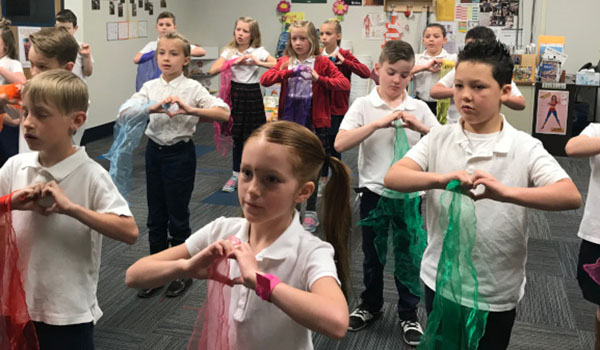
Lesson Summary
- Explore a celebration of art and timeless wisdom through the book From the Heart of Africa.
- Learn and perform an African-inspired welcome song and dance.
Lesson Plan and Procedure
Lesson Key Facts
- Grade(s): 2
- Subject(s): Dance, Music, Social Studies
- Duration of lesson: 30-60 minutes
- Author(s): Miriam Bowen
Preparation
Make visuals of the following words, to help teach how we welcome and who we welcome: thoughts, words, song, heart, children, parents, teachers, community (as shown below in figure 1).
Introduction
Gather students in a circle and play the game “Telephone.” Choose one of the aphorisms from the book, such as “Unity is strength” or “Many hands make light work,” as a message to pass along.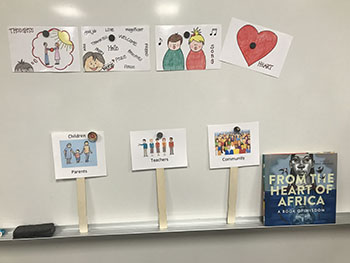
How to play the game “Telephone”:
- Players sit or stand in a circle.
- The teacher whispers a word or phrase into the ear of the person to his or her right. Each person continues passing the message in whispered tones until it reaches the end of the circle.
- Have the last person say out loud the message he or she received. Compare the beginning message to the ending message.
Teacher: An aphorism is a brief sentence or phrase that expresses an opinion or makes a statement of wisdom. Spoken or written, aphorism literally means “definition.” This book is a collection of aphorisms from the continent of Africa.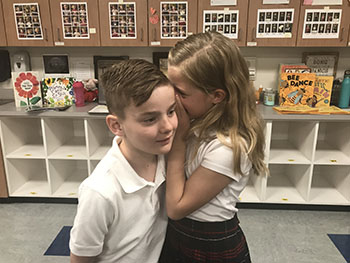
(For more information, see https://examples.yourdictionary.com/aphorism-examples.html.)
Read the book From the Heart of Africa by Eric Walters.
Teacher: Aphorisms occur in all human societies but are especially common in oral-based societies found in Africa. African children begin to learn aphorisms from their elders at a very young age. These bits of wisdom are passed by word of mouth from generation to generation. Author Eric Walters says, “They are used as a way to communicate: to make arguments and defend ideas, settle quarrels and find common ground; as a form of entertainment; and as a way to praise a person or community.”
Group Discussion and Reflection
Use the game “Telephone” as a springboard for discussion and reflection with your students. Compare the passing of information from one person to another to the African custom of passing wisdom by word of mouth. Discussion questions may include the following:
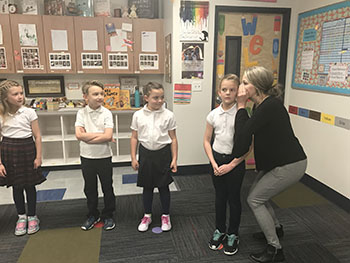
- Is active listening important?
- Do small misconceptions make a difference?
- What is my role in sharing information?
- What is my role in receiving information?
- Can I connect these ideas and experiences to school or other areas of my life?
- What are aphorisms that have been passed on to me?
- What is an aphorism I can create to share with others?
Turn to the page with this aphorism: “The longest journey starts with a single step.” Read the aphorism and its origin and meaning. Allow for comments, reaction, and connections to the aphorism.
Aphorism: “The longest journey starts with a single step.”
Origin: African proverb
Meaning: “Every Journey has a beginning and an end, and often the hardest part is at the start. Sometimes tasks seem too big, but by taking just one step, you’re one step closer to achieving success.”
Teacher: This aphorism can help us with many new experiences. Can you take the first step in learning a welcome song and dance from Africa with me?
Funga Alafia
Background Information
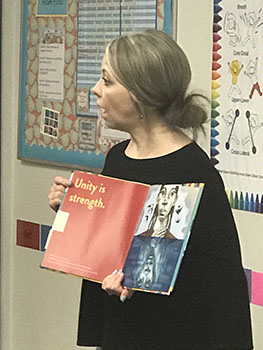 There are many different ideas as to the meaning of this song and its origins. I chose the following because of the message I wanted to teach my students. You may use this one or research your own to meet your objectives.
There are many different ideas as to the meaning of this song and its origins. I chose the following because of the message I wanted to teach my students. You may use this one or research your own to meet your objectives.
"Funga" is a traditional Liberian rhythm & dance. "Funga Alafia" is a song which was composed by an African American to be sung while performing versions of that African rhythm and dance. The melody is the same as “Little Liza Jane,” and it has a call-and-response pattern that can be used. It is considered to be a welcome song and dance and is perfect to use for a class performance.
According to N. Kumah of Liberia, the gestures for the dance translate to the following:
“I come to you with outstretched hands, gracefully.
From my mouth, I welcome you.
From my heart, I reach out to the earth.
I reach out to the creator.
From the east to the west, north to the south, all are welcome.
There are no splinters for you to walk on.
When I was hungry, you gave me food to eat.
When I was tired, you gave me a place to rest.
From the bottom of my heart, FANGA—welcome.”
Teach the song and movements to “Funga Alafia” using Janice Buckner—Peace Around the World: https://www.youtube.com/watch?v=dFGuzajAc7k.
Note: Below is a sample of the words to "Funga Alafia” with their accompanying movements. For the full document with all the verses, see our attached PDF.
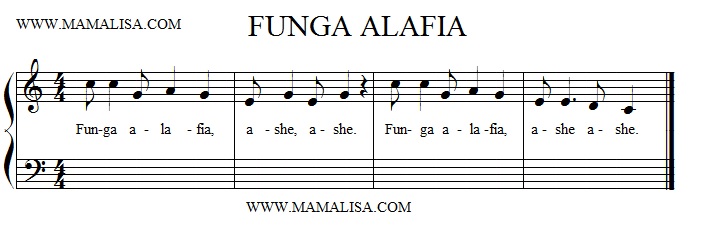
“Funga Alafia" Words with Accompanying Movements

Funga – tap hands to heart
Alafia – reach hands to the sky
Ashe – tap hands to heart
Ashe - reach hands to the sky
Repeat
Funga – tap hands to heart
Alafia – reach hands to earth
Ashe – tap hands to heart
Ashe – reach hands to earth
Repeat
With our thoughts, we welcome you ashe, ashe – tap pointer finger to brain
With our words, we welcome you ashe, ashe – tap pointer finger to mouth
With our song, we welcome you ashe, ashe – cup hands around edges of mouth
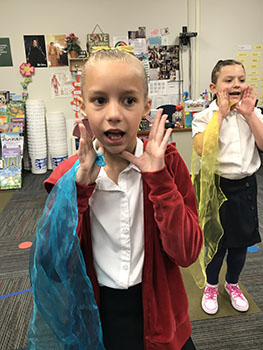
With our hearts, we welcome you ashe, ashe – tap heart or shape a heart with hands and place over heart
Repeat chorus two times
All you children, we welcome you, ashe, ashe – swing hands back and forth at hip level
All your parents, we welcome you, ashe, ashe – swing hands back and forth at shoulder level
All your teachers, we welcome you, ashe, ashe – sway hands over head
Your community, we welcome you, ashe, ashe – hands circle around and around
Repeat chorus two times
As the students become familiar with the words and movement, colorful scarves can be added as a prop, and small rhythm instruments can be used as well.
The class can be divided into two groups and perform for each other, giving each student a turn performing and being part of the audience. This is the perfect setting to teach and establish performance etiquette, which includes the following:
- Focusing on the performers, noticing what they do
- Crossing legs and holding still while watching
- No talking or laughing during the performance
- Clapping at the conclusion to show appreciation and respect for the performers
Teacher: There are many ways to help someone feel welcome, as the song suggests. Some are verbal and others are nonverbal. How do we welcome with our thoughts and our hearts? Share what each suggested way of welcoming might look like. 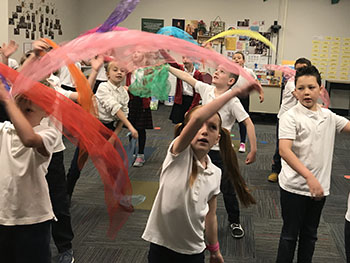
Discuss characteristics of being a good citizen in a community, neighborhood, school, and classroom. Have each student identify his or her role as a good citizen.
Extensions
You can use the song and dance as an opening piece to a class program or other school event.
Have each student create a book of aphorisms and illustrations.
Learning Objectives
- Create and perform a dance consisting of short remembered sequences.
- Sing a song using a natural, unstrained voice.
- Examine and identify ways to show respect within the classroom and community.
Utah State Board of Education Standards
This lesson can be used to meet standards in many grades and subject areas. We will highlight one grade’s standards to give an example of application.
Grade 2 Dance
Standard 2.D.CR.4: Reflect on movement choices and change movement through guided improvisational experiences or short remembered sequences.
Standard 2.D.P.6: Demonstrate a variety of movement qualities while dancing.
Standard 2.D.CO.2: Observe a dance and relate the movement to the people or environment in which the dance was created and performed.
Grade 2 Music
Standard 2.M.P.4: Sing folk, traditional, and call-and-response songs in tune, using a natural, unstrained voice.
Standard 2.M.P.10: Demonstrate persistence and cooperation in refining performance pieces.
Grade 2 Social Studies
Standard 2.1.2: Use primary sources to identify how their community has changed or remained the same over time, and make inferences about the reasons why.
Standard 2.3.2: Describe the rights and responsibilities of citizens in the United States and Utah.
Equipment and Materials Needed
- "Funga Alafia” full document with all verses and accompanying movements PDF.
- Book: Walters, E. From the Heart of Africa: A Book of Wisdom. Toronto: Tundra Books, 2018.
- Hand drum, maracas
- Visuals of children, parents, teachers, communities, thoughts, words, songs, hearts
- Colorful scarves
- Music: Janice Buckner—Peace Around the World (DBA Moonlight Rose Productions)
Additional Resources
- Fanga drum rhythms: https://www.youtube.com/watch?v=nuQFbD43P4k
- Definition of Fanga (dance): https://en.wikipedia.org/wiki/Fanga_song
- Nan Malaya—“Funga Alafia”: https://www.youtube.com/watch?v=GTegkMJq15M
- Pancocojams: http://pancocojams.blogspot.com/2011/11/real-history-of-funga-alafia-fanga-song.html
- The story of Fanga, from Sule Greg Willson: https://dance1400.wordpress.com/2011/09/12/the-story-of-fanga-from-sule-greg-wilson/
- International music and culture: https://www.mamalisa.com/?t=eh
- Another version of the song: “Sarah Barchas Bridges Across the World” (High Haven Music)
Image References
Images 1–3: Brenda Beyal.
Image 4: James Huston.
Image 5-9: Brenda Beyal.

www.education.byu.edu/arts/lessons
 Download
Download